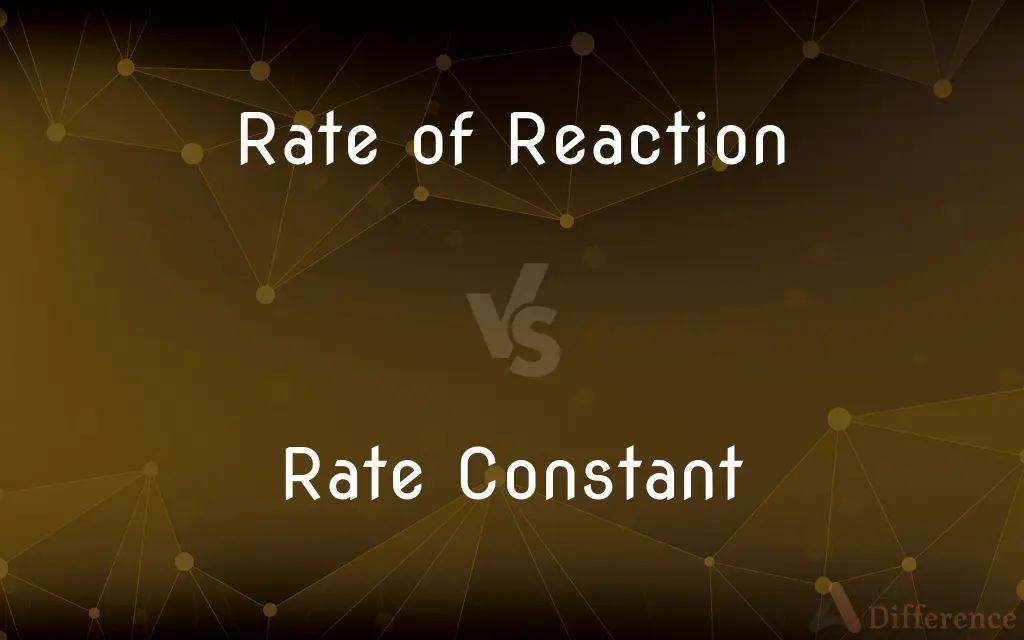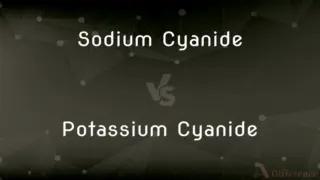Rate of Reaction vs. Rate Constant — What's the Difference?
By Tayyaba Rehman — Published on November 19, 2023
Rate of Reaction measures how fast reactants turn into products; Rate Constant is a proportionality factor in the rate equation.

Difference Between Rate of Reaction and Rate Constant
Table of Contents
ADVERTISEMENT
Key Differences
Rate of Reaction represents the speed at which reactants transform into products in a chemical reaction. It often is quantified as a change in concentration over time. Depending on the reaction, this rate can be influenced by various factors such as concentration, temperature, and presence of catalysts.
Rate Constant, on the other hand, is a specific parameter in the study of kinetics. It's the proportionality factor in the rate equation that relates the Rate of Reaction to the concentrations of reactants. Unlike the Rate of Reaction, the Rate Constant is typically not affected by the concentration of reactants but can change with temperature or the presence of catalysts.
While the Rate of Reaction can vary significantly based on conditions and concentrations, the Rate Constant for a particular reaction at a given temperature remains constant. This distinction makes the Rate Constant a valuable parameter in predicting how a reaction will proceed under different conditions.
The two terms, Rate of Reaction and Rate Constant, are intimately related in the realm of chemical kinetics. The Rate of Reaction provides an observable measure of a reaction's speed, while the Rate Constant offers a more intrinsic understanding, tying together the relationship between the Rate of Reaction and the reactant concentrations.
Comparison Chart
Definition
Speed at which reactants form products
Proportionality factor in the rate equation
ADVERTISEMENT
Dependency
Can vary with conditions
Typically constant at a given temperature
Relationship
Observable measure of reaction speed
Links Rate of Reaction to reactant concentrations
Units
Varies (e.g., mol/L·s)
Varies based on reaction order (e.g., 1/s)
Application
Indicates reaction progress
Predicts reaction behavior under conditions
Compare with Definitions
Rate of Reaction
It measures the change in concentration over time.
The Rate of Reaction was determined by measuring the decrease in reactant concentration.
Rate Constant
Rate Constant is the factor in a reaction's rate equation.
For a first-order reaction, the Rate Constant has units of 1/s.
Rate of Reaction
Different factors like temperature can influence it.
Adding a catalyst dramatically increased the Rate of Reaction.
Rate Constant
Can vary between different reactions.
The Rate Constant for the decomposition of hydrogen peroxide differs from that of the hydrolysis of esters.
Rate of Reaction
Represents how quickly reactants are consumed or products formed.
A slower Rate of Reaction meant the experiment took longer.
Rate Constant
Its value can predict reaction behavior.
A larger Rate Constant suggests a faster reaction.
Rate of Reaction
Can be determined experimentally.
The scientist measured the Rate of Reaction using a spectrophotometer.
Rate Constant
It links the Rate of Reaction to reactant concentrations.
The equation relates the Rate of Reaction to the Rate Constant and reactant concentration.
Rate of Reaction
Rate of Reaction denotes the speed of a chemical reaction.
The Rate of Reaction increased when the temperature rose.
Rate Constant
Remains unchanged at a particular temperature.
Despite changing reactant concentrations, the Rate Constant remained the same.
Common Curiosities
What factors can influence the Rate of Reaction?
Concentration, temperature, presence of catalysts, and surface area can influence it.
How is Rate Constant useful in predicting reactions?
It ties the Rate of Reaction to reactant concentrations, helping predict reaction behavior.
How is Rate of Reaction different from Rate Constant?
Rate of Reaction measures reaction speed, while Rate Constant is a factor in the rate equation.
Does Rate Constant have units?
Yes, its units vary based on the reaction order.
Does the Rate Constant change with a catalyst?
A catalyst can change the Rate Constant by providing an alternative reaction pathway.
How does temperature affect the Rate Constant?
Typically, as temperature increases, the Rate Constant also increases, but this can vary.
Can the Rate of Reaction change during an experiment?
Yes, the Rate of Reaction can change based on conditions like concentration or temperature.
How is the Rate Constant found in a rate equation?
It's typically determined experimentally by measuring Rate of Reaction at various reactant concentrations.
Is Rate Constant affected by changing reactant concentrations?
No, Rate Constant is typically independent of reactant concentrations but varies with temperature.
Can two different reactions have the same Rate Constant?
It's unlikely, as the Rate Constant is specific to a particular reaction at a given temperature.
Why might the Rate of Reaction decrease over time in a reaction?
As reactants are consumed, their concentrations decrease, leading to a slower Rate of Reaction.
How is the Rate of Reaction determined experimentally?
It's often determined by measuring the change in concentration of reactants or products over time.
What happens to the Rate of Reaction if the Rate Constant increases?
A higher Rate Constant typically means a faster Rate of Reaction, all else being constant.
Can the Rate of Reaction be zero?
Yes, if there's an equilibrium or no reactants are present, the Rate of Reaction can be zero.
Are the Rate of Reaction and Rate Constant always directly proportional?
Not always. Their relationship is defined by the rate equation, which depends on the reaction order.
Share Your Discovery

Previous Comparison
Whatman Filter Paper vs. Normal Filter Paper
Next Comparison
Sodium Cyanide vs. Potassium CyanideAuthor Spotlight
Written by
Tayyaba RehmanTayyaba Rehman is a distinguished writer, currently serving as a primary contributor to askdifference.com. As a researcher in semantics and etymology, Tayyaba's passion for the complexity of languages and their distinctions has found a perfect home on the platform. Tayyaba delves into the intricacies of language, distinguishing between commonly confused words and phrases, thereby providing clarity for readers worldwide.












































